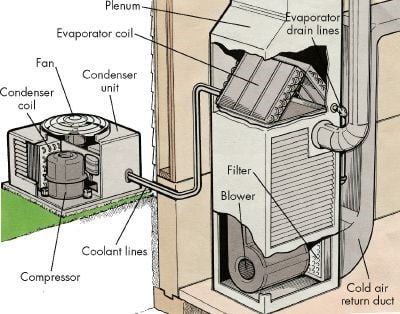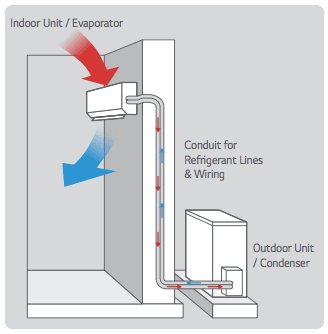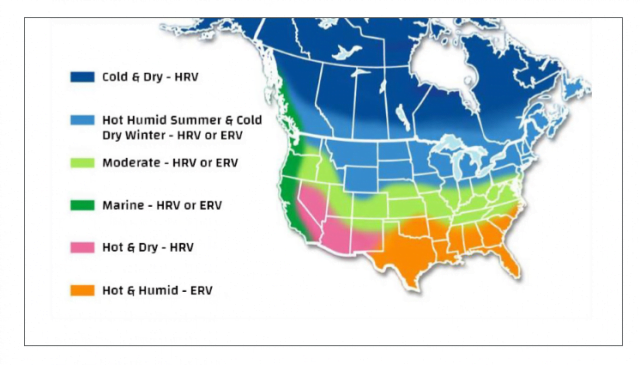Our Services
New Home HVAC Installation
A good duct system will deliver air to the designated rooms with no air leaks and with little heat loss or gain while travelling through the ducts. The proper amount of registers per room, type of insulation, type of windows, etc are all very important when creating a duct layout. Duct performance impacts energy efficiency, operating costs, comfort and indoor air quality.
HVAC Repairs & Replacement
A good contractor will look for air leaks, measure air flow, and inspect your insulation to make sure all components meet HVAC guidelines and the manufacturer’s specifications. Again, the proper amount of registers per room, type of insulation, type of windows, are all factors when quoting. Sometimes it is worth having an HVAC contractor look at your existing ductwork for signs of failing energy efficiency.
Experienced contractors will note energy losses. 48% of a home’s energy consumption is dedicated to HVAC and 1/3 of energy is lost out the windows and doors from lack of seal.
Signs of Bad Ductwork Design
- Rooms that are chronically too hot or too cold
- Furnaces and A/C units that fail manufacturer’s energy efficiency specifications
- Very noisy airflow (interrupts tv and conversations)
- Uncomfortable air currents and drafts that come from vents
- Excess indoor humidity
- Unexplained heating and cooling expenses
Repairs can add up to be costly and less effective in long run. We will make sure the most cost effective solution is found whether that means repair or replacing.
Ductwork Cleaning & Repair
A good duct system will deliver air to the designated rooms with no air leaks and with little heat loss or gain while travelling through the ducts. The proper amount of registers per room, type of insulation, type of windows, etc are all very important when creating a duct layout. Duct performance impacts energy efficiency, operating costs, comfort and indoor air quality.
Learn About HVAC Systems
Single Stage Furnace
This is the most AFFORDABLE to buy but LEAST ENERGY EFFICIENT option. It is less prone to breakdowns and less to repair. Single stage means one single-speed blower motor and gas flame is either on or off. Temperature swings can be up to +/- 4 degrees. You may find warm or cold spots in certain areas of your home and your home temperature may spike and drop over time. When house temperature gets cold the furnace turns on to full capacity (one BTU). These have 80% AFUE.
In other words, “Annual Fuel Utilization Efficiency” or AFUE of 80% would mean that 80% of the fuel burned by this heater can be used as useful heat to warm your house, and the other 20% is wasted through your exhaust vent.
2 Stage Furnace
This is more expensive to buy than single stage but LESS NOISY and MORE ENERGY EFFICIENT as it runs at lower BTU during stage 1 and stage 2 (higher BTU) will kick in only if stage 1 cannot maintain set temperature. In turn these use less fuel as they are not constantly running on high. Less temperature swing (+/- 2 degress off set point) as this furnace distributes heat more evenly. And with longer run times it helps keep air circulating thus improving indoor air quality. Fewer stops and starts also reduce wear and tear on components helping extend lifespan. These have 96% AFUE.
Modulating/Variable Furnace
Modulating are going to the most expensive option but most energy efficient. Instead of having 1 or 2 stages these have about 70 stages. The furnace has a burner that adjusts the amount of fuel burned incrementally in order to maintain a consistent temperature. You can compare these to driving on a highway rarely having to press on gas pedal vs driving in the city with more abrupt starts and stops. These furnaces only use as much energy as they have to. It gauges how much the furnace has to work in 1% increments resulting in the most evenly distributed heat and prevent hot and cold spots within a home. These use 80% less energy and are rated 98+ AFUE.
Downfall can be age of home as insulation and duct layout plays a huge factor so homes over 30 years old don’t see efficiency with these.

How an Air Conditioner Works
Natural physics….When a liquid converts to a gas it absorbs heat.
ACs do this by forcing special chemical compounds “REFRIGERANTS” to evaporate and condense over and over again in a closed system of coils. ACs also contain fans that move warm interior air over these refrigerant filled cold coils.
As hot air flows over the cold, low-pressure coils, the refrigerant inside the coils absorbs heat as it changes from a liquid to a gas.
To keep cooling efficiently, the AC has to convert the refrigerant gas back to a liquid. This is where a COMPRESSOR now takes the gas and puts under high pressure. This process creates unwanted heat. All this heat, created by compressing the gas, is then filtered outdoors with the help of a second set of coils called CONDENSER COILS and a second fan.
As the gas cools, it changes back to a liquid, and the process starts all over again.
Air Conditioning is nothing more than a continuous cycle where refrigerant is chilling the indoor air and the resulting gas is being continually compressed and cooled for conversion back to a liquid again.
Watch video link below to fully understand how AC works
https://www.youtube.com/watch?v=QWD3O1TyJRg
TYPES OF AC SYSTEMS
CENTRAL AC
This system uses ducts to deliver the air to each room of your home. With existing forced heat system installed, central ac can use the same ducts or new ducts can be added just for the purpose of delivering the cooled air. With central AC, the CONDENSING UNIT is installed outdoors. This is then hooked up to the existing furnace, or an AIR HANDLER if using a HEAT PUMP, via COOLANT LINES and then run to the EVAPORATOR COIL (which is installed on the furnace or contained within the air handler)

Ductless AC
These consists of an outdoor unit and an indoor unit. The outdoor unit is installed on or near the exterior wall of the room that you wish to cool.
Installation of these systems is much simpler because it does not require ductwork. Rather, the indoor and outdoor units are connected with a set of electrical wires and tubing.
You can have more than one indoor unit connected to a single outdoor unit as well. This makes it easy to cool multiple rooms or maintain the temperature throughout a large room via the use of two indoor cooling units.

Ductless air conditioners are much easier to install in homes that do not already contain ducts. They fit directly into the walls but can also be suspended from the ceiling or installed in a drop ceiling. The condenser is kept outside, and only hoses are needed to travel between the units. A small hole is required to install, which makes the installation fast and simple. You can purchase units that will handle a single room or up to four rooms at a time.
As you can see from Mitsubishi https://mhiaa.com.au/products/category/residential/ceiling-concealed-systems/
Advantages include a much quieter system as the parts of an ac that make the most noise are the compressor and the fan that cools the condenser. In a split system, the compressor and fan for the condenser are located outside the room being cooled and therefore the major sources of noise are removed.
Another plus is Energy is saved on bills as well. Without a network of ducts, there is very little opportunity for heat or energy loss. Many centralized A/C units lose a lot of energy due to heat exchange in the air duct system.
A downfall is that ductless units requires its filter to be washed a minimum of once a month to maintain it. Very important as ductless fans cannot handle accumulating debris, and if you ignore maintenance and a professional cleaning is required, you’ll spend hundreds of dollars and possibly shorten the life of your system.

Photo from https://www.daikin.com/products/ac/lineup/split_multi_split/
HEAT PUMPS
During the summer months the heat pump operates like a traditional air conditioner to cool the home. During cooler months, the heat pump reverses the process to extract heat from the outside air and brings it inside the home to provide heat.

A HEAT PUMP is an air conditioner which has a reversing valve, allowing it to run in reverse in turn heating your house instead of cooling it.

An air source heat pump is like a heat sponge by absorbing heat from the outdoor air. Because they use outside air, air source heat pumps work well in moderate temperatures. But when temperatures drop below 0°C/32° F, they lose efficiency, meaning they have to rely on a secondary source of heat to properly heat your home. Secondary sources include:
- Electric resistance coil heaters
- Gas Furnace aka Dual Fuel System
Electric resistance coil heaters
Normally the default as they are the cheaper backup heat options for heat pumps. They’re generally installed into the ductwork of your home. Electric resistance heaters have a 100% efficiency rating, which means every 1 kilowatt-hour of electricity turns into 1 kilowatt-hour of heat delivered to your home. Not so efficient compared to the heat pump which has about 300% energy efficiency.
So if temperatures stay below freezing for a long time, the heat pump will have to use the electric resistance coils more and you will definitely notice a huge cost increase on your energy bill.
Gas furnace (dual fuel system)
The other backup heat option is having a gas furnace.
This system is more expensive upfront than the electric resistance coil heaters, but will be more energy efficient in long run as the coils require about 3 times as much energy to deliver heat compared to a gas-powered unit.
HEAT PUMP vs FURNACE?
Heat pumps have quite a few advantages with the top being their energy efficiency.
A heat pump uses electricity to transfer heat from one area to another, which means that it never has to generate heat itself. It simply transfers the heat that already exists from either the outside of a house to the inside or vice versa.
A heat pump is also more environmentally friendly because it requires no fossil fuels to heat your home.
Heat pumps, although more efficient than most furnaces, are also more expensive to operate. This is because electricity (used to power heat pumps) is typically more expensive than the natural gas or propane used to power furnace.
Climate will play a big factor in your decision too. Mild climate benefit from heat pumps where climates with longer colder winters will do better on a furnace.
Heat Pump Maintenance
In order to keep your heat pump operating efficiently, proper maintenance is necessary:
- Replace air filters every 30-60 days.
- The heat pump should be completely level, supported by a concrete support pad.
- Never stack anything on top of the unit.
- Maintain a minimum 2-foot clearance around the entire unit.
- You can improve heat pump efficiency with shade from trees, trellises, and awnings.
- Periodically check your outdoor unit and clear away grass clippings, leaves, dirt, snow, and other debris (you can use your garden hose).
Before the energy crisis of the 1970s, homes had what you can call natural ventilation thanks to lack of insulation and gaps around doors and windows. This meant poor comfort, heat loss and little control over air quality. These days we have much better insulation so we don’t have to lose heat and houses are built at much higher standards of air tightness– but that creates a new problem of getting fresh air in homes now.
Air recirculation became an important issue. Early air exchangers were an answer to the problem; HRV and ERV units are newer and better versions of these devices. Both are air exchange systems that help to enhance indoor air quality and minimize heating.
Both will help…
- Exhaust, stale, polluted, humid air.
- Reduce condensation, mould, mildew, etc
- Transfer heat from stale, damp, exhaust air to preheat (or cool, in summer) fresh incoming air.
- Save energy costs by helping the furnace and/or a/c to work less.
HRV
An HRV captures and recycles heat. Polluted exhaust air is used the heat to warm incoming fresh air. So in the winter, by the laws of physics, whenever air is warmed, it’s humidity is reduced as warm air can absorb moisture. Thus cold incoming outdoor air is automatically dehumidified when it is warmed by the re-cycled heat.
At the same time, humid warm indoor air, which has absorbed moisture and contains other indoor air pollutants, is exhausted. As the exhaust air passes through the HRV, the exhaust air heat is captured by the Heat Exchanger which heats the incoming cold outdoor air.
In the summer, homes WITH A/C, the HRV heat exchanger captures cooled energy, and used it to cool the warm outdoor air as it is introduced into the home, for ventilation. This reduces the energy on the a/c system while providing 100% fresh air ventilation.
The HRV can only dehumidify outdoor air when the outdoor air is colder than the inside air (law of physics as stated earlier). In homes without a/c it is possible for the indoor air temperature to be several degrees cooler than the outside air temperature. If this is the case, the HRV will cool the incoming fresh air, by recycling the cooler energy that is retained indoors, and using this energy to cool the outdoor air as it is introduced into the home.
How HRVs work

ERV
Since they transfer moisture (core absorbs moisture from air), they help prevent excess dryness in the cold season and reduce the demands on the air-conditioning system in the warm season. ERVs are best suited for colder, drier climates in winter as they help limit the amount of humidity expelled from your home.
Venmar diagrams this best…
https://www.venmar.ca/22-detail-advice-hrv-and-erv-why-choose-a-erv-energy-recovery-ventilator-.html

Important points about ERV…
- No Drain Install Required – An ERV will not produce any condensation, therefore saving the cost of the drain pan and installing a drain.
- In cold climates, when using an ERV, 40-60% of the humidity that would normally be exhausted is transferred to the fresh incoming air helping to maintain the relative humidity at a comfortable level.
- Energy Savings – An ERV can also create energy savings by removing or reducing the need to operate a humidifier in the winter and less energy to be used by a/c in summer.
So… HRV or ERV?
Several factors play a role.
1. Climate – Generally HRVs work better in the milder, more humid winters and Moderate humid to dry summers. ERVs are better for hot humid summer climates.
As you can see from Lifebreath link below, the lower mainland would fall between zone 2 or 4 which could warrant either.
https://www.lifebreath.com/wp-content/uploads/2018/02/Specifications-Catalogue-Nov2017.pdf

ZONE 1: True North – Cold Winter and Dry Summer – HRV HRV is best for a very cold and prolonged winter season as the robust aluminum HRV core will have a long life.
ZONE 2: US Canada Border – Cold Winter and Hot Humid Summer – HRV or *ERV with Defrost HRV is best for a cold or prolonged winter. ERV will help reduce the AC load in the summer by transferring moisture. ERV needs a defrost system for areas experiencing cold (freezing) winter temperatures.
ZONE 3: Central US – Moderate Climate – HRV or ERV HRV and ERV will work equally well. ERV will help reduce the AC load in the summer by transferring moisture. ERV does not require a cold weather defrost system.
ZONE 4: Marine Climate – HRV or ERV Humidity and temperature are moderated by HRV or ERV. ERV typically does not need a cold winter defrost system with some exceptions in mountainous areas.
ZONE 5: Arid – Hot and Dry – HRV HRV will transfer energy summer and winter. With little moisture to transfer an ERV is not needed.
ZONE 6: Gulf Region – Hot and Humid – ERV ERV is recommended. Primary benefit is transferring energy and moisture thoughout summer and winter without negatively impacting AC load.
2. How AIRTIGHT is your home? The less air leaks, the more humidity stays in, making the HRV the way to go.
3. Type of heating system – In a wood-heated environment, which is more likely to be drier, an ERV will promote a healthier humidity level.
4. Home SIZE – In general, HRV units are best suited to small or medium-sized homes as humidity can quickly accumulate. ERVs, therefore,will better serve larger homes where the air tends to be drier.
5. Number of Occupants – An HRV fits the needs of a larger, active family that generates a lot of humidity. In a home with a few people less humidity is generated and the drier the air will be. In this situation the ERV is the better choice.
***Studies have been done to support the use of ERVs***
The National Research Council of Canada- Residential energy-efficient moisture control through ERV http://www.nrc-cnrc.gc.ca/ci-ic/article/v17n4-13
Studies showed that ERVs may have benefits over HRVs both in cold dry winters and humid summers due to ERVs having the ability to transfer moisture.
”A summer field study on HRV and ERV performance for a range of summer conditions was carried out using the twin houses at the NRC Canadian Centre for Housing Technology in Ottawa. The ERV was found to provide better humidity control (i.e., providing a lower level of indoor relative humidity), as well as lower air conditioning electricity consumption, measured as the cumulative saving of 12% over a week”
And in extreme dry winters studies proved ERV more effective at retaining moisture within the home.
Merv vs Hepa Filters
MERV is an acronym for “Minimum Efficiency Reporting Value”. The MERV scale ranges from 1 to 20 and rating of over 16 can remove up to 75 percent of all airborne particles 0.3 microns or greater from the air.
HEPA stands for “High Efficiency Particulate Air filters”. These filters are the extensively efficient. True HEPA rated air filters have a MERV of 17-20. HEPA filters meet standards that remove at least 99.97% of airborne particles down to the size of 0.3 microns.
Hepa filters are designed for applications where contaminants must be trapped on the first go round. For example, you wouldn’t want viruses circulating in the air in a hospital, so the facility would probably be equipped with HEPA filtration.
As this chart from Wikipedia illustrates the MERV ratings and filtration abilities based on the ratings.

Which filter to get will come down to your own specific needs. In most cases, you can strike a good balance between air cleanliness and HVAC efficiency with a MERV-rated filter. Remember that the air in your home is recirculated, especially if you have a MODULATING furnace, so the same air will pass through your filter multiple times each day. After several rounds, each of which captures up to 75 percent of airborne particles, your air will get plenty clean, without requiring the extra energy that HEPA filtration would.
Improving Air Quality Tips
Indoor air quality can be just as bad as outdoor. Having an efficient filter and filtration system can be crucial to your families health. Air contaminants include…
Smog ( can be a mix of carbon monoxide,nitrogen dioxide, ozone, and/or sulfur dioxide), Mold&Fungus, Bacteria (eg Legionella), Dust Mites, Pollen&Spores.
Please see the Health Canada link below for tips.
https://www.canada.ca/en/health-canada/services/air-quality/improve-indoor-air-quality.html#a2
Zone Control Systems
A zone can be an individual room, a group of rooms or a whole floor of your home. A zone controlled system uses a control panel to open and shut dampers that are distributed throughout your ductwork in turn, blocking or releasing hot or cold air. By having one thermostat, you can adjust the zones easily. The two main benefits of installing this kind of system are energy efficiency and money saving. This also results in overall increased home comfort.
You can combine a modulating furnace and zoning control to have the best of both worlds. This approach gives you control for each zone and system that varies intensity depending the outdoor temperature and unique needs of each zone. This combination results in optimal temperature comfort.




